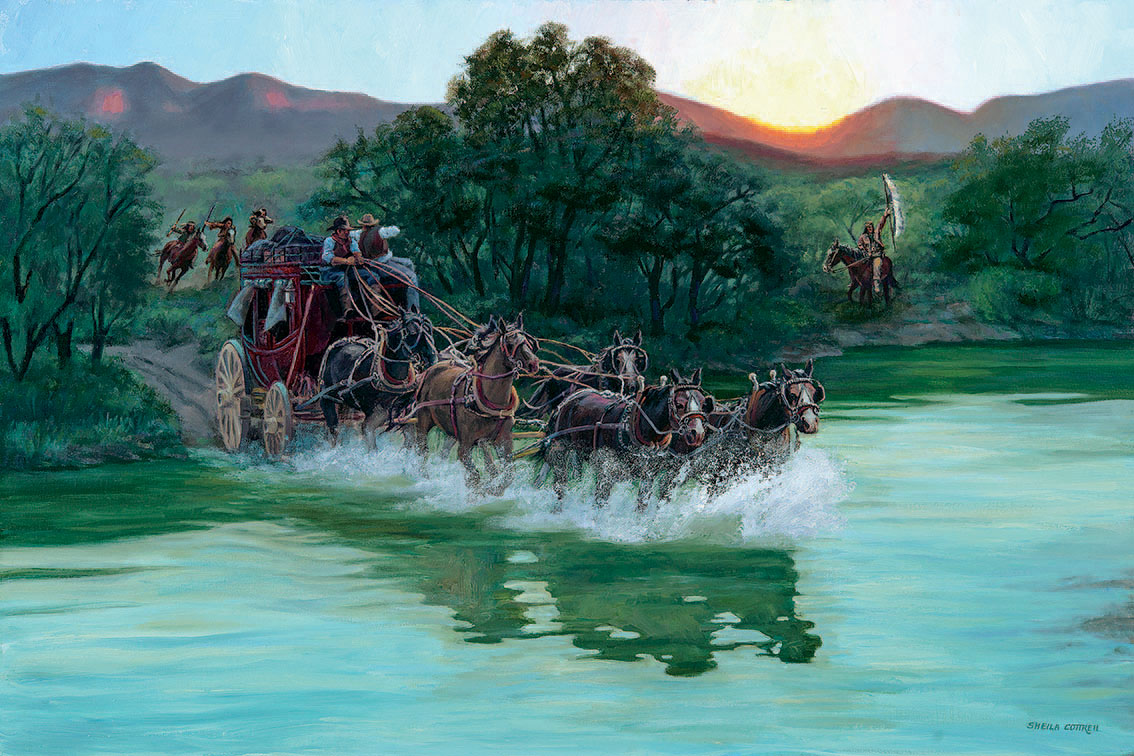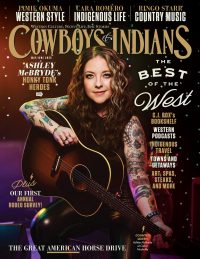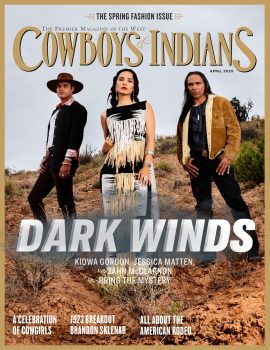The artist’s ranching roots and childhood inspire her portrayals of the Old West.
“If you don’t use your talents, they will be taken away from you.” The Sunday school teacher’s words frightened 5-year-old Sheila Cottrell out of a pleasant daydream, and she determined from that moment to diligently study art.
Even at a young age, she was naturally gifted in drawing and was often praised for her budding skill. It would be some decades before she’d discover that the “talents” her Bible teacher referred to were actually an ancient measure of money. But it would take far less time to discover the subject that would forever inspire her art: the West.
Cottrell’s roots in the West run generations deep. “I enjoy painting anything to do with the West — past or present — but especially love illustrating the tales of pioneering adventures my family experienced. My ancestors lived four generations in Texas before arriving by covered wagon train at Fort Bowie in Cochise County, Arizona, in 1900. R.G. Wells was a deputy sheriff in Tombstone and had numerous run-ins with horse thieves and rustlers. Most of my family was very successful in ranching, but I was most intrigued when my father once confided, in a low voice, a not-to-be-repeated cloud on our family history: His granddad had two great-uncles hanged for horse thieving.”
Cottrell fondly recounts childhood inspirations and memories of camping under expansive Arizona night skies and full moons. Often unable to sleep because of the “too-bright light” in her eyes, she marveled at all the colors she was able to see in the moonlight and the forms she could make out in the shadows. “I’ve always been intrigued with nocturnes. I grew up camping in the canyons of the Chiricahuas, reading westerns, and imagining Apaches skulking just over the rim above me. The mountains had been their stomping grounds, and while I was fascinated with the wild tales about them, I also felt too much was made of their atrocities and not enough of their humanity.”
While studying art at the University of Arizona, Cottrell grew disillusioned with the uncompromising push for “modern” style that didn’t allow her to figuratively represent the West.
“I struggled because if I produced anything recognizable, I barely got a passing grade!” Though her paintings sold readily, her lack of personal satisfaction in them — coupled with an agonizing fear that they would ultimately come back to embarrass her — drove the young artist to sign her works with her Spanish name. It wasn’t until 1992 that she began signing her real name.

Equally disappointing was Cottrell’s observation that the great painters of the past did not give the “Old West” the veneration she felt it deserved. “It seemed for much of the last century, Western subjects were treated in a humorous or cartoonish way.” It wasn’t until she saw paintings by Cowboy Artists of America member James E. Reynolds that she was able to fully engage with the work.
In Cottrell’s estimation, Reynolds — who has been credited with helping to achieve critical acceptance and recognition of the post-Russell and Remington Western art revival that began in the 1960s — introduced a new and exciting style to the subject. His use of color, composition, and even his handling of the paint itself unlocked dimensions she found irresistible. Tracking down the master to enlist his help, the cowgirl artist would find the man himself irresistible as well.
“I didn’t consider my art education really began until I took two of his workshops at the Scottsdale Artists’ School in 1984,” Cottrell says. “After that, we were a couple until his death in 2010.” The two traveled extensively to uncover fresh material, attending brandings, visiting friends’ ranches, and exploring mountain ranges from the Mexican border to the Canadian Rockies.
Like her longtime companion Reynolds, Cottrell loves representing the West in paint. “I love everything about what I do — from the lush, buttery oil paints and the smells to creating beauty on what was just a few hours before a blank white canvas. I admit I tend to romanticize the West. In my family, it is genetic. I think people have lost the romance in their lives. With technological changes in our world expanding at an alarming rate ... many people feel the need to create a more comforting sense of ambience in their own personal space. To me, and many people like me, images of the Old West help fill this need.”
Sheila Cottrell is represented by Big Horn Gallery in Tubac, Arizona. She will be exhibiting at Small Works, Great Wonders November 11 – December 31 at the National Cowboy & Western Heritage Museum in Oklahoma City; The Great American West November 19 at Settlers West Galleries in Tucson, Arizona; Mountain Oyster Club Art Show November 20, 2016 – January 14, 2017, in Tucson; Cowgirl Up! March 24 – May 7, 2017, at the Desert Caballeros Western Museum in Wickenburg, Arizona; and Night of Artists March 31 – May 14, 2017, at the Briscoe Western Art Museum in San Antonio.
From the November/December 2016 issue.














